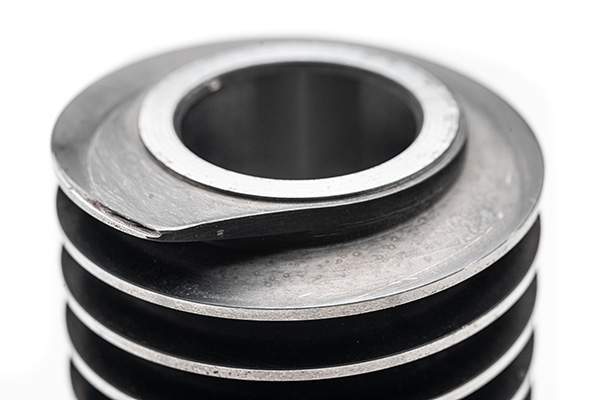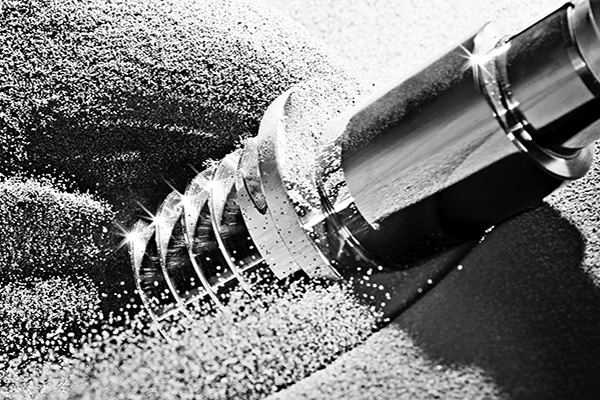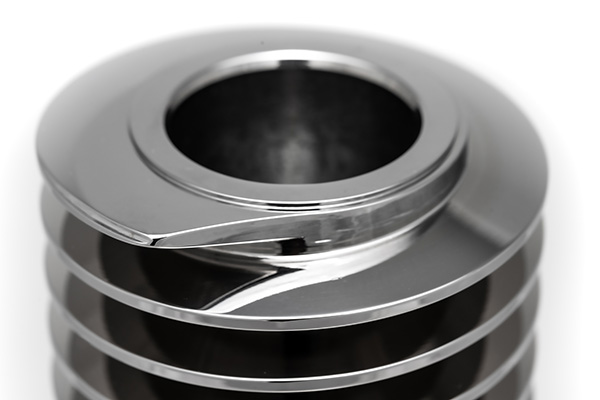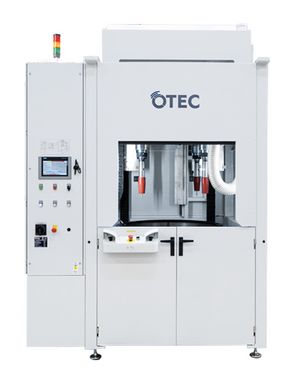FOOD INDUSTRY: EXTRUDER SCREWS PERFORM BETTER WITH EVENLY SMOOTHED SURFACES
Schaaf Technologie GmbH relies on OTEC stream finishing process
Extruders are used in almost every part of the food industry. They are turned and milled using blanks with the required material characteristics. The manufacturing process causes chatter marks and rough surfaces that significantly impair extrusion performance, which is why the screws are currently ground and polished by hand.
SMOOTHING ROUGH SURFACES AND ROUNDING EDGES
Extruders are used for a variety of conveyed goods. They move not only bulk goods but also viscous masses such as dough. It is easy to assume that a rough surface helps to “grip” and move the product. But it actually does the opposite. First, a rough surface is prone to food residue and micro-organism deposits, which makes surface cleaning much harder. Second, sharp, unstable edges are a drawback since they can repeatedly break off when under stress, leaving small fragments in the food. The only way to prevent this, and to guarantee uninterrupted production and food purity, is smooth, even surfaces in even the smallest angles, and rounded, stable edges.
MANUAL PROCESSES ARE COSTLY
Generally speaking, components used in the food industry are post processed in several steps. First, a belt grinder is used to smooth the surface as much as possible. Then the hard-to-reach areas are painstakingly smoothed by hand and the edges manually rounded. As extruders can be heavy and unwieldy, this can take several hours. And for those doing the work, the risk of injury from sharp edges is high.
ACHIEVING SURFACE QUALITY EFFICIENTLY
The most efficient way to obtain evenly smoothed surfaces and rounded, stable edges is customised post processing with OTEC stream finishing technology: a mechanised, reliable, repeatable process for smoothing and edge rounding. Targeted, controlled processing ensures that the extruder screw can do its job unimpaired: no catching, no increased resistance and no deposit build-ups.



AT SCHAAF TECHNOLOGIE, MANUAL FINISHING IS A THING OF THE PAST
Schaaf Technologie GmbH manufactures screw extruders. Manually post processing the parts after turning and milling used to take the company around four hours. The workpiece went through three steps: First, milling tracks along the longitudinal axis were manually removed with a belt grinder. In step two, after hardening, the outer diameter of the screw was ground using a cylindrical grinder, producing undesirably sharp edges. In the last step these edges had to be rounded, and fine sandpaper used to obtain the finished smooth surface by rubbing off the scale caused by hardening. Schaaf Technologie has consigned all of this manual post processing to history by switching to OTEC’s efficient stream finishing process.
Schaaf Technologie Production Manager Ron Hanke:
“The OTEC stream finishing process means that we can process our screw surfaces automatically, evenly and consistently. The new process also improves tribological properties all-round, which in turn extends the service life of the parts by reducing friction. The process now takes just 30 minutes, and the time it takes for our employees to load the machine is minimal. We even obtain a better surface result than we did with manual finishing. The OTEC stream finishing process gives us a huge advantage in terms of both quality and time.”

NO MORE WORKING AT A SNAIL’S PACE
OTEC’s stream finishing (SF) process, which was developed in-house, is ideal for particularly complex geometries. Components are clamped in a holder and lowered into a rotating container filled with an abrasive or polishing medium. The workpiece is also rotated to produce an even finish. This makes it feasible to achieve highly refined surfaces with roughness depths of up to Ra 0.01 µm even on the most complex geometries – all without manual strain or risk of injury.
The enormous machining forces used in stream finishing can remove material faster and more precisely than any other type of surface processing. It is also easy to store and retrieve custom process programs, ensuring repeatability.
OTEC’s latest innovation, the SF-HP, can even process large and heavy workpieces with a diameter and length of up to 650 mm and a maximum weight of up to 200 kg.
PUT OTEC’S EXPERTISE TO GOOD USE IN YOUR BUSINESS
MECHANICAL GRINDING AND ROUNDING
- Precision rounding down to the last micron, customised to your requirements
- Homogenous, stable edges
- Extends workpiece service life without compromising quality
- No product contamination from broken edge fragments
SURFACE POLISHING AND SMOOTHING FOR A MIRROR FINISH
- Fewer sticky material deposits on components
- Improves the workpiece’s tribological properties
- Reduces friction and wear

DEFINE YOUR PROCESS WITH THE HELP OF OTEC PRÄZISIONSFINISH EXPERTS
Our specialist team at the OTEC Finishing Center is ready to assist in defining your process – whatever the tool geometry, surface structure or edge-rounding requirements. Work with us to identify exactly the right process for your component. Arrange an appointment today to take part in your sample processing. See here for more information on sample processing.




